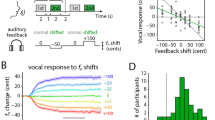Abstract
This study proposes an auditory-centered training system using solmization to artificially acquire and train absolute pitch by providing vocal feedback of musical notes through a musician’s voice. Most current training systems and applications for absolute pitch acquisition have focused on providing visual feedback. However, many people having perfect pitch describe that they hear music as words rather than envisioning visual notes. Therefore, we propose a training system that does not require a graphical user interface. In an experiment with 10 participants, our system’s training with vocal feedback improved six non-potential absolute pitch users’ absolute pitch by approximately 25%, although extant system with visual feedback didn’t make an improvement.
Access this chapter
Tax calculation will be finalised at checkout
Purchases are for personal use only
Similar content being viewed by others
Notes
- 1.
https://www.clubdam.com/app/dam/seimitsusaiten/, Accessed on Jan 18, 2021.
- 2.
https://apps.apple.com/jp/app/id1015269208, Accessed on Jan 18, 2021.
- 3.
https://apps.apple.com/jp/app/id763325064, Accessed on Jan 18, 2021.
- 4.
https://apps.apple.com/jp/app/id942373213, Accessed on Jan 18, 2021.
References
Ashby, W.R.: An Introduction to Cybernetics. Chapman & Hall Ltd., Boca Raton (1961)
Bachem, A.: Absolute pitch. Physcol. Bull. 161(1948), 1180–1185 (1948)
Callaghan, J., Thorpe, W., van Doorn, J.: The science of singing and seeing, pp. 15–18 (2004)
Christiansen, L.H., Frederiksen, N.Y., Jensen, B.S., Ranch, A., Skov, M.B., Thiruravichandran, N.: Don’t look at me, i’m talking to you: investigating input and output modalities for in-vehicle systems. In: Campos, P., Graham, N., Jorge, J., Nunes, N., Palanque, P., Winckler, M. (eds.) INTERACT 2011. LNCS, vol. 6947, pp. 675–691. Springer, Heidelberg (2011). https://doi.org/10.1007/978-3-642-23771-3_49
Crutchfield, W.: There may be more to music than meets a typical ear. The New York Times (1990)
Duan, Z., Gupta, C., Percival, G., Grunberg, D., Wang, Y.: SECCIMA: singing and ear training for children with cochlear implants via a mobile application (2017)
Gaver, W.W.: Auditory icons: using sound in computer interfaces. Hum. Comput. Interact. 2(2), 167–177 (1986). https://doi.org/10.1207/s15327051hci0202_3
Guardati, L., Casamassima, F., Farella, E., Benini, L.: Paper, pen and ink: an innovative system and software framework to assist writing rehabilitation. Presented at the (2015). https://doi.org/10.7873/DATE.2015.0453
Hoppe, D., Sadakata, M., Desain, P.: Development of real-time visual feedback assistance in singing training: a review. J. Comput. Assist. Learn. 22(4), 308–316 (2006). https://doi.org/10.1111/j.1365-2729.2006.00178.x
Howard, D.M.: Technology for real-time visual feedback in singing lessons. Res. Stud. Music Educ. 24(1), 40–57 (2005). https://doi.org/10.1177/1321103X050240010401
Howard, D.M., Welch, G.F.: Microcomputer-based singing ability assessment and development. Appl. Acoust. 27(2), 89–102 (1989). https://doi.org/10.1016/0003-682X(89)90002-9
Itoh, K., Suwazono, S., Arao, H., Miyazaki, K., Nakada, T.: Electrophysiological correlates of absolute pitch and relative pitch. Cerebral cortex (New York, N.Y. : 1991) 15, 760–769 (2005). https://doi.org/10.1093/cercor/bhh177
Kin Wah Edward, L., Anderson, H., Hamzeen, H., Lui, S.: Implementation and evaluation of real-time interactive user interface design in self-learning singing pitch training apps (2014). https://doi.org/10.13140/RG.2.1.1757
Kuber, R., Tretter, M., Murphy, E.: Developing and evaluating a non-visual memory game. In: Campos, P., Graham, N., Jorge, J., Nunes, N., Palanque, P., Winckler, M. (eds.) INTERACT 2011. LNCS, vol. 6947, pp. 541–553. Springer, Heidelberg (2011). https://doi.org/10.1007/978-3-642-23771-3_41
Langfeld, H.S.: Psychological monographs. Psychological Review. Publication (1932)
Leong, S., Cheng, L.: Effects of real-time visual feedback on pre-service teachers’ singing. J. Comput. Assist. Learn. 30(3), 285–296 (2014). https://doi.org/10.1111/jcal.12046
Matsuda, M., Igarashi, H., Itoh, K.: Auditory t-complex reveals reduced neural activities in the right auditory cortex in musicians with absolute pitch. Front. Neurosci. 13, 809 (2019)
Nakano, T., Goto, M., Hiraga, Y.: MiruSinger: a singing skill visualization interface using real-time feedback and music CD recordings as referential data. In: Ninth IEEE International Symposium on Multimedia Workshops (ISMW 2007), pp. 75–76 (2007). https://doi.org/10.1109/ISM.Workshops.2007.19
Nylander, S., Jacobsson, M., Tholander, J.: Runright - real-time visual and audio feedback on running (2014). https://doi.org/10.1145/2559206.2574806
Profita, J., Bidder, T.G.: Perfect pitch. Am. J. Med. Genet. 29(4), 763–771 (1988). https://doi.org/10.1002/ajmg.1320290405
Richardson, P., Kim, Y.: Beyond fun and games: a framework for quantifying music skill developments from video game play. J. New Music Res. 40(4), 277–291 (2011). https://doi.org/10.1080/09298215.2011.565350
Rossiter, D., Howard, D.: Albert: a real-time visual feedback computer tool for professional vocal development. J. Voice Official J. Voice Found. 10(4), 321–336 (1996). http://europepmc.org/abstract/MED/8943135
Shiraishi, M., Ogasawara, K., Kitahara, T.: HamoKara: a system that enables amateur singers to practice backing vocals for karaoke. J. Inf. Process. 27, 683–692 (2019). https://doi.org/10.2197/ipsjjip.27.683
Takeuchi, A.H., Hulse, S.H.: Absolute pitch. Psychol. Bull. 113(2), 345–361 (1993). https://doi.org/10.1037/0033-2909.113.2.345
Welch, G., Himonides, E., Howard, D., Brereton, J.: VOXed: Technology as a meaningful teaching aid in the singing studio, pp. 166–167 (2004)
Welch, G., Howard, D., C, R.: The SINGAD (singing assessment and development) system: A classroom-based pilot study with poor pitch singers. Canad. J. Music Educ. Res. Edn. (1988)
Wiener, N.: Cybernetics: or Control and Communication in the Animal and the Machine, 2nd edn. MIT Press, Cambridge (1948)
Author information
Authors and Affiliations
Corresponding author
Editor information
Editors and Affiliations
1 Electronic supplementary material
Below is the link to the electronic supplementary material.
Supplementary material 1 (mp4 138698 KB)
Rights and permissions
Copyright information
© 2021 IFIP International Federation for Information Processing
About this paper
Cite this paper
Yoshida, N., Namikawa, K., Koroyasu, Y., Nagatani, Y., Ochiai, Y. (2021). Auditory-Centered Vocal Feedback System Using Solmization for Training Absolute Pitch Without GUI. In: Ardito, C., et al. Human-Computer Interaction – INTERACT 2021. INTERACT 2021. Lecture Notes in Computer Science(), vol 12935. Springer, Cham. https://doi.org/10.1007/978-3-030-85610-6_1
Download citation
DOI: https://doi.org/10.1007/978-3-030-85610-6_1
Published:
Publisher Name: Springer, Cham
Print ISBN: 978-3-030-85609-0
Online ISBN: 978-3-030-85610-6
eBook Packages: Computer ScienceComputer Science (R0)





